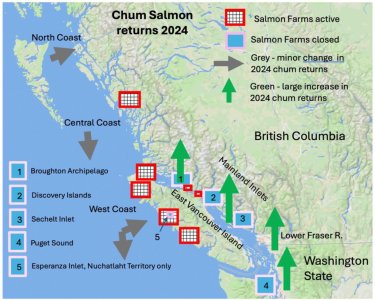AA: you know chum are a species that returns vary greatly with the brood year size having no correlation to returns. It us so variable that DFO does not really try to Forcast chum returns. I can think of many examples where large chum returns were expected and it was a bust and also the opposite. That being said it is nice to see any good returns including rivers close to farms.
I'm glad to see they mention ocean survival as a likely reason for the returns.
What will Elmo say next year if returns are not so good?
Quite a bit to unpack within your assertions, HG. The short answer is: "It's complicated & complex".
The Pacific salmon species that I would expect would have less "noise" within the stock recruitment relationships between juvies and adults would be pinks - because they have a 2 YO wrt life history verses a 3-6 YO life history for the other Pacific salmon. They don't get to make decisions to postpone returning until the next year if ocean conditions suck like it did during the blob. After the blob went away - the proportion of 5 & 6 YOs in the returning salmon spawners increased in some species like Chinook - as the adults decided to wait it out an extra year as many of the creeks were too hot to enter.
And pinks and chums have the smallest & most vulnerable smolts wrt sea lice loading from FFs as lice mortality is size-mediated (or more accurately weight-moderated). So these are the canaries in the coal mine to assess effects from sea lice loading - but not the only species that are affected by other vectors like diseases - like PRv. Chinook are more likely affected there - especially WCVI Chinook juvies in and around Tofino/Clayoquot Sound FFs.
Another very significant issue for all species is - how do we determine accurate numbers of outmigrating juvies and match them to accurate numbers of returning adults from the same cohort a few years later?
Well which creeks have both smolt & adult fences? Not many. Not many accurate data points/locations that we can use to match cohorts. And one also needs to do scale analysis on the returning adult spawners to tease out the age/cohort groups.
Specifically with chum - they have been subject to a 1-2 punch, besides FF/sea lice. Chum spawn generally at the bottom of watersheds and their eggs in the females ripen in the salt chuck and when ready - they rush in and spawn fast. Residence time is often as low as 5 days verses 30+ for coho. But that's where the seiners used to get them - just outside the creeks - and historically they knocked most populations down. Many populations now only have 1 minor run - verses 2 decent runs (early & late). And the early run (often 3rd week of August - 1st week September) is particularly vulnerable to the effects of warmer creek water giving those incubating eggs a jump up on their ATUs and early emergence. On a hot year and a hot summer - those juvies might emerge into the estuaries as early as late February/early March - when there is nothing to eat yet (esp. harpactacoid copedopds) as they are 1-2 months earlier than they should be. Those juvies likely die and not seen nor counted in any smolt fence or trawl.
And lastly, chum move around way more than most other species of Pacific salmon. Their CUs are accordingly considerably larger than most watersheds for most areas. So, hard to track stream-specific runs to specific juvie numbers even if those numbers existed and were accurate. There would have to be an accurate DNA testing program to accompany the returns - and I doubt if the DNA was even able to differentiate many watershed-specific stocks.
I don't think that DFO actually counts chum in many creeks - especially accurately with a fish fence - and that's actually the reason why "DFO does not really try to Forecast chum returns". They have exceeding limited data on adults and next to nothing on juvies. Hard to model anything w/o data.
And then there is the discussion on migratory routes and tracking juvies past FFs to determine sequential and cumulative sea lice loading. That's quite a project in of itself.
The best & most practical option therefore is to compare & contrast any available watersheds with accurate smolt & adult fences - close to FFs and away from likely effects of FFs and see if those patterns are significantly different over time, esp. after FFs are removed.









